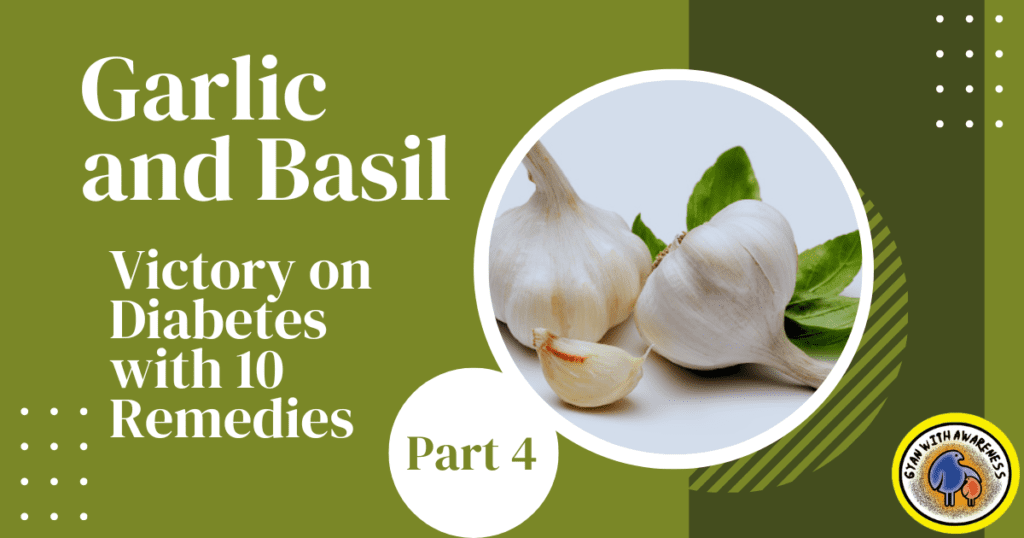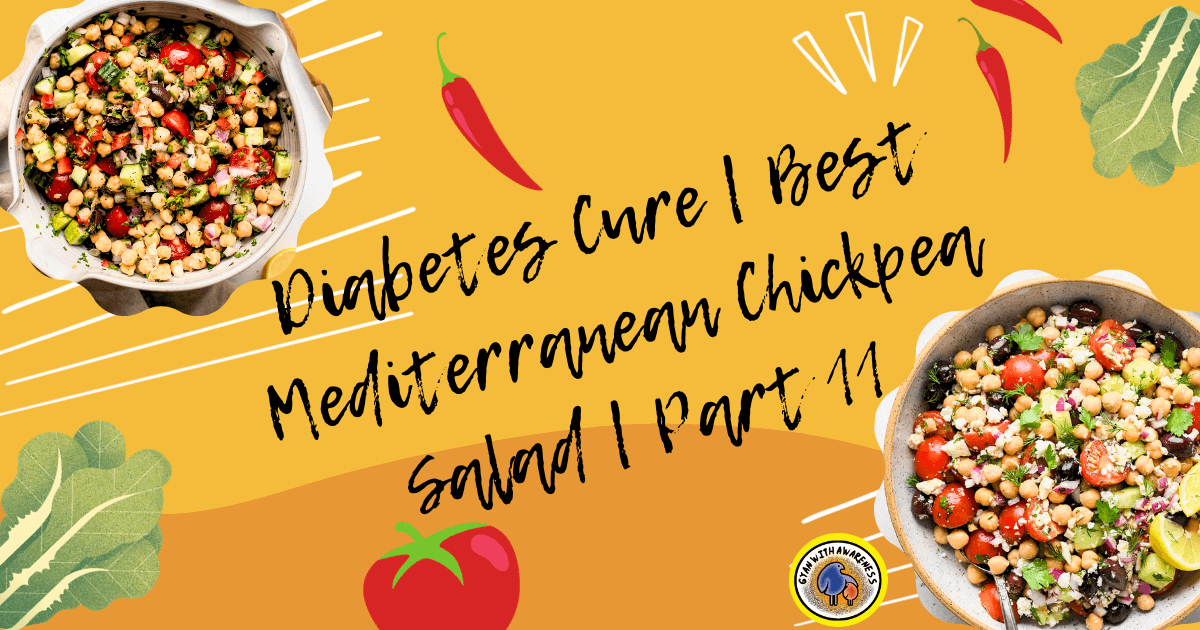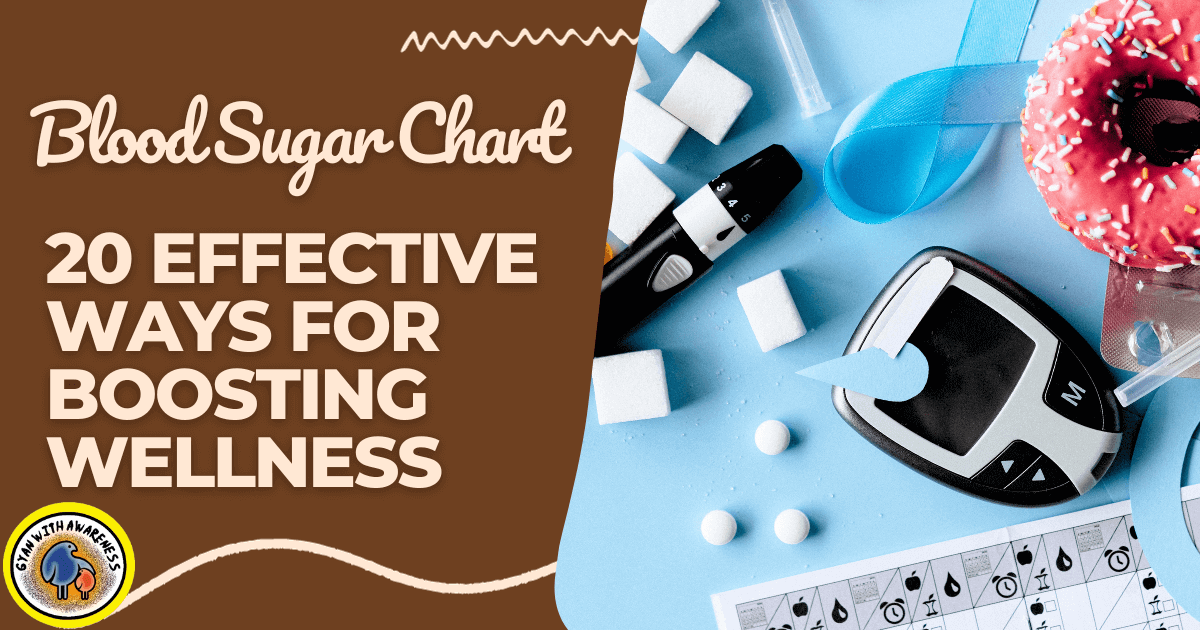Welcome to “Garlic and Basil: Victory on Diabetes with 10 Remedies- Part 4”. Garlic and basil, celebrated not only for their culinary allure but also for their potential health benefits, hold a special place in the quest for effective diabetes management. These two natural wonders have garnered attention for their unique qualities that might influence blood sugar levels and enhance insulin sensitivity. Garlic, with its bioactive compounds, and basil, rich in essential nutrients, has intrigued researchers exploring complementary strategies for diabetes care.
As we delve into the distinctive attributes of garlic and basil and their potential impact on diabetes, we uncover a compelling narrative of how these kitchen staples may offer insights into improved well-being for those navigating the challenges of diabetes.
In this segment, we continue our journey of discovering effective and accessible remedies for managing diabetes naturally. We explore the potential benefits of specific foods, herbs, lifestyle modifications, and alternative therapies in supporting blood sugar control, reducing inflammation, and promoting overall wellness.
In the realm of natural remedies for diabetes, the dynamic duo of garlic and basil emerges as a compelling contender. Both celebrated for their culinary prowess, garlic, and basil also harbor potential benefits that extend to diabetes management. These aromatic ingredients, steeped in tradition and health-promoting qualities, have piqued scientific curiosity. From garlic’s active compounds that may influence blood sugar levels to basil’s potential role in enhancing insulin sensitivity, this exploration uncovers the unique attributes that make garlic and basil an intriguing addition to the arsenal of tools in the fight against diabetes.
From the power of superfoods to the therapeutic properties of ancient practices, we provide insights and practical tips to empower individuals with diabetes to take charge of their health. As always, it’s essential to consult with healthcare professionals and maintain regular monitoring of blood sugar levels while incorporating these remedies into your diabetes management plan. Let’s explore the holistic approach to diabetes care and discover the wonders of natural home remedies.
Natural home remedies for diabetes and their health advantages:
Holistic Strategy:
To effectively manage diabetes, which is a complex condition, a comprehensive strategy is needed. Natural home cures focus on total health and well-being as an alternative and supplement to traditional treatments.
Individualized Care:
People with diabetes can tailor their treatment regimens using natural home remedies to suit their requirements and preferences. It provides a variety of choices, including dietary changes, herbal treatments, stress management strategies, and lifestyle modifications.
Minimizing Side Effects:
Many conventional diabetes medications may come with unwanted side effects. Natural home remedies offer a way to manage diabetes without or with minimal side effects, reducing the risk of complications associated with long-term medication use.
Empowerment and Self-Care:
Incorporating natural remedies empowers individuals to take an active role in their diabetes management. It promotes self-care, self-awareness, and self-empowerment, allowing individuals to make informed choices and take control of their health.
Complementary Approach:
Natural home remedies can complement conventional treatments for diabetes. They can enhance the effectiveness of medications, support blood sugar control, improve overall health markers, and provide additional tools for managing the condition.
Read More: Rosemary: Victory on Diabetes with 10 Remedies- Part 1
Remedies:
Remedy With Garlic:
The potential health benefits of garlic, particularly its advantages in the control of diabetes, are well known. The following list of five gargle-based treatments for diabetes includes:
Garlic Remedy Recipes:
1. The eating of raw garlic:
Consuming two to three raw garlic cloves each day on an empty stomach is a rapid and effective remedy. The active ingredient allicin, which is present in raw garlic, may increase insulin sensitivity and aid with blood sugar regulation.
2. Tea with garlic:
Crushed garlic cloves are boiled in water for a short time to make garlic tea, which is then strained and consumed. This process enables the release of garlic’s beneficial components into the tea. Regularly drinking garlic tea may have anti-inflammatory and blood sugar-regulating effects.
3. Garlic and Honey Mixture:
Mix crushed garlic with a teaspoon of honey and consume it. Honey is known for its natural sweetness and potential health benefits. When combined with garlic, it can create a tasty and beneficial remedy. This mixture may help improve insulin sensitivity and support overall blood sugar control.
4. Lemon and garlic juice:
Half a lemon’s juice should be squeezed and combined with smashed garlic. Vitamin C, which has antioxidant effects, is present in lemon juice and gives it a tart flavor. To promote blood sugar regulation, this medicine combines the potential advantages of both garlic and lemon.
5. Garlic Capsules:
Garlic supplements or capsules are available in the market and can be taken as directed by a healthcare professional. These capsules contain concentrated forms of garlic extract, ensuring a consistent dosage of the active compounds found in garlic. Garlic capsules may be suitable for individuals who prefer a more convenient and standardized way of incorporating garlic into their routine.
Garlic’s health benefits for diabetic conditions:
Blood Sugar Regulation:
Garlic’s active compounds may help lower blood sugar levels by improving insulin sensitivity and increasing insulin secretion.
Improved Insulin Sensitivity:
Garlic could enhance the body’s response to insulin, aiding glucose uptake by cells and promoting better blood sugar control.
Anti-Inflammatory Properties:
Garlic’s anti-inflammatory effects might help reduce inflammation often linked to insulin resistance.
Heart Health:
Garlic may lower cholesterol and triglyceride levels, reducing cardiovascular risks commonly associated with diabetes.
Antioxidant Power:
Garlic’s antioxidants combat oxidative stress, decreasing the risk of diabetes-related complications.
Blood Pressure Regulation:
Garlic may help lower blood pressure, beneficial as hypertension is a frequent concern for diabetics.
Reduced Atherosclerosis Risk:
Garlic’s potential to improve blood lipid profiles may reduce the risk of atherosclerosis, a common complication of diabetes.
Enhanced Immunity:
Garlic’s immune-boosting properties can be advantageous for those with compromised immunity due to diabetes.
Gut Health:
Garlic might have prebiotic effects, promoting a healthy gut microbiome, which could have implications for diabetes management.
Easy Incorporation:
Adding garlic to various dishes is a simple way to potentially harness its benefits for diabetes and overall health.
It’s important to remember that while garlic offers these potential advantages, consulting healthcare professionals before making significant dietary changes is crucial, especially for individuals with diabetes or underlying health conditions.
While garlic has shown encouraging results in the control of diabetes, it should not be used in place of prescription drugs or medical guidance. Before adopting any new treatments or supplements into your regimen, it is advisable to speak with a physician, especially if you have underlying medical concerns or are using drugs that may interact with garlic.
Medicinal Basil Remedy:
The herb holy basil, sometimes referred to as tulsi, has a long history of usage in conventional Ayurvedic treatment. It is well-known for its possible health advantages, particularly its function in the treatment of diabetes. Here are five holy basil treatments that may be advantageous for diabetics:
Recipes for Holy Basil Remedies:
1. Medicinal Basil Tea:
One common and easy approach for swallowing holy basil is to brew tea by steeping the leaves in hot water. Due to the tea’s possible anti-diabetic qualities, blood sugar levels may be regulated when consumed warmly or coldly.
2. Juice of basil:
Adding holy basil to your diet also involves squeezing the juice from the leaves and consuming it. The juice can be consumed on its own or combined with other juices for added flavor and potential health benefits.
3. Dried Basil and Amla:
A potent combination is produced by combining holy basil powder with amla powder, which is made from Indian gooseberry. This mixture may aid in controlling the amount of sugar in the blood and promoting general health.
4. Holy Basil and Honey:
Mixing crushed holy basil leaves with honey forms a potent remedy that can be consumed daily. The combination of holy basil and honey may have anti-diabetic effects and help maintain blood sugar control.
5. An oil from Holy Basil:
When using holy basil essential oil, experts recommend using it topically or aromatically. Being able to handle stress is key for preserving stable blood sugar levels, hence the aroma of holy basil essential oil is known for its stress-relieving effects.
Benefits of Holy Basil in Diabetic Condition:
Blood Sugar Control:
Holy basil may help lower blood sugar levels by influencing insulin secretion and enhancing glucose uptake by cells.
Insulin Sensitivity:
Active compounds in holy basil could improve insulin sensitivity, promoting better blood sugar regulation.
Antioxidant Protection:
Holy basil’s antioxidants combat oxidative stress, reducing the risk of diabetes-related complications.
Anti-Inflammatory Effects:
Its anti-inflammatory properties might help mitigate inflammation linked to insulin resistance.
Stress Reduction:
Holy basil is known as an adaptogen, potentially aiding in stress management, which can impact blood sugar levels.
Cardiovascular Health:
Holy basil may lower cholesterol levels and support heart health, crucial for diabetics at increased cardiovascular risk.
Liver Function:
Holy basil might protect the liver and aid in detoxification, important for overall health in diabetes.
Enhanced Immunity:
Its immune-modulating properties can be beneficial for individuals with compromised immunity due to diabetes.
Neuroprotection:
Holy basil’s neuroprotective effects might have implications for preventing nerve damage (neuropathy) associated with diabetes.
Easy Integration:
Holy basil can be consumed as a tea, supplement, or added to dishes, providing diverse options for incorporating its potential benefits.
As with any natural remedy, consulting healthcare professionals before making significant dietary changes is essential, especially for those with diabetes or underlying health conditions. Integrating holy basil into a balanced diabetes management plan, alongside medical guidance, can offer potential advantages for blood sugar control and overall well-being.
While holy basil has demonstrated potential benefits for managing diabetes, it should not be used in place of prescription drugs or medical guidance. Before introducing holy basil or its cures into your regimen, it is essential to speak with a healthcare provider or an Ayurvedic practitioner, especially if you have underlying health concerns or are taking drugs that may interfere with it.
Remedy with Green Tea:
The numerous health advantages of green tea, which may help with the treatment of diabetes, have made it a well-liked beverage. Here are five treatments that make use of green tea that are advantageous for diabetics:
Green Tea Remedy Recipes:
1. Regular Intake:
To benefit from green tea’s possible health benefits, drink 1-2 cups of it every day. The catechins found in green tea are potent antioxidants that may enhance insulin sensitivity and control blood sugar levels.
2. Green Tea with Cinnamon:
Brew green tea as usual and add a pinch of cinnamon for added flavor and potential blood sugar regulation. Cinnamon has been shown to have anti-diabetic properties, and combining it with green tea can create a delightful and beneficial beverage.
3. Lemon and green tea:
To improve the flavor and potential health benefits of your green tea, squeeze some fresh lemon juice into it. It is a great source of antioxidants and vitamin C, which can promote general health and possibly help with better blood sugar regulation.
4. Green Tea Smoothie:
Blend green tea with fruits and vegetables to create a nutritious and diabetes-friendly smoothie. Adding green tea to a smoothie provides an extra dose of antioxidants and can be a refreshing way to enjoy its benefits along with other wholesome ingredients.
5. Green Tea Ice Cubes:
Brew green tea and freeze it into ice cubes. Add these green tea ice cubes to water or other beverages for a refreshing twist. This can be a great way to stay hydrated while enjoying the antioxidant properties of green tea.
Benefits of Green Tea in diabetic Conditions:
Antioxidant Power:
Rich in antioxidants like catechins, green tea helps reduce oxidative stress and inflammation often associated with diabetes, potentially lowering the risk of complications.
Heart Health:
Green tea consumption has been linked to improved cardiovascular health by reducing LDL cholesterol levels and triglycerides, which are important for managing diabetes-related heart risks.
The ability to reduce diabetes:
Green tea includes substances that can increase insulin sensitivity and help reduce the amount of sugar in the blood, assisting insulin in maintaining better glycemic control.
Weight management:
The substances in green tea can help people with diabetes who are overweight maintain their weight by enhancing metabolism and improving fat oxidation.
Blood Pressure Control:
Regular use of green tea may help to control blood pressure, which is essential for avoiding complications from diabetes.
Effects on Inflammation:
Green tea’s anti-inflammatory effects can help manage chronic inflammation, which is frequently present in diabetes, and lower the risk of associated problems.
Prevention of Neuropathy:
Green tea’s neuroprotective properties may help prevent or lessen diabetic neuropathy, a frequent nervous system issue.
Kidney Protection:
According to some studies, green tea’s antioxidants may assist safeguard kidney function, which is important for diabetics because they are more likely to develop renal issues.
Liver Health:
Since diabetes can affect liver health, green tea’s potential to enhance liver function may be especially pertinent for diabetics.
Blood Lipid Management:
Regular use of green tea may result in positive changes in lipid profiles, lowering the risk of cardiovascular problems that frequently accompany diabetes.
In particular, if you have diabetes or any other medical condition, remember to speak with a healthcare provider before making major dietary changes.
It’s also important to note that green tea includes caffeine, albeit in lower concentrations than coffee. Caffeine sensitivity or special dietary limitations should be taken into account when determining how much to consume. To get the most out of green tea while taking into consideration individual preferences and health conditions, moderation and dietary changes should always be made.
In conclusion, the incorporation of garlic, green tea, and basil as remedies for diabetes holds promising potential in improving the management of this chronic condition. Garlic’s bioactive compounds exhibit anti-diabetic effects by enhancing insulin sensitivity and reducing blood sugar levels. Green tea’s rich antioxidant content, along with its ability to regulate blood sugar and lipid levels, offers multifaceted benefits to individuals with diabetes, aiding in glycemic control and reducing the risk of complications. Basil, with its natural compounds like eugenol, demonstrates anti-inflammatory and hypoglycemic properties, contributing to improved insulin function and overall metabolic health.
While these remedies can be valuable additions to a diabetes management plan, they should be viewed as complementary to medical advice and prescribed treatments. It’s crucial for individuals with diabetes to consult their healthcare providers before incorporating these remedies into their routine, ensuring a well-rounded and effective approach to diabetes care that addresses individual needs and medical considerations.
FAQ:
What is a normal blood sugar after meal?
The average range for postprandial blood sugar, also known as postprandial blood sugar, in most people is between 140 and 180 mg/dL (7.8 to 10 mmol/L). This level can change based on things including the kind and amount of carbohydrates ingested, individual metabolic reactions, and how soon after a meal blood sugar is measured. Through facilitating the uptake of glucose into cells for energy or storage, the body’s insulin response is essential in ensuring that blood sugar levels stay within this range.
It’s crucial to keep in mind that ideal post-meal blood sugar levels can vary for diabetics, who may aim for levels that are closer to the normal range to reduce issues. Regular observation, a healthy diet, and effective drug control are crucial tactics.
What is a normal blood sugar 1 hour after eating?
Often referred to as postprandial blood sugar, a normal blood sugar level an hour after eating typically ranges from 140 to 180 mg/dL (7.8 to 10 mmol/L). This range can change depending on the meal’s nutritional content, each person’s metabolism, and the precise moment the measurement was taken. Maintaining post-meal blood sugar levels within this range is crucial for diabetics to reduce the risk of problems. However, based on individual health circumstances and treatment strategies, ideal objectives may vary. Effective diabetes care includes regular blood sugar testing, a nutritious diet, and the right medications. Consulting a healthcare professional ensures that the advice is tailored to the patient’s needs.
What is normal sugar by age?
Normal blood sugar levels can vary slightly by age. Generally, for adults and non-pregnant individuals, a fasting blood sugar level of 70-100 mg/dL (3.9-5.6 mmol/L) is considered normal. However, it’s important to note that specific target ranges may differ for various age groups, such as children, elderly individuals, and pregnant women. Consulting with a healthcare professional helps determine appropriate blood sugar targets based on age, overall health, and any underlying medical conditions. Regular monitoring and a healthy lifestyle are essential to maintaining stable blood sugar levels across all age ranges.









